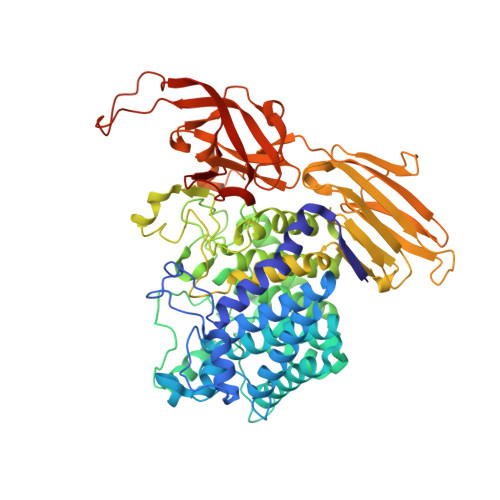Crystal structure of glycoside hydrolase family 127 beta-l-arabinofuranosidase from Bifidobacterium longum.
Ito, T., Saikawa, K., Kim, S., Fujita, K., Ishiwata, A., Kaeothip, S., Arakawa, T., Wakagi, T., Beckham, G.T., Ito, Y., Fushinobu, S.(2014) Biochem Biophys Res Commun 447: 32-37
- PubMed: 24680821
- DOI: https://doi.org/10.1016/j.bbrc.2014.03.096
- Primary Citation of Related Structures:
3WKW, 3WKX - PubMed Abstract:
Enzymes acting on β-linked arabinofuranosides have been unknown until recently, in spite of wide distribution of β-l-arabinofuranosyl oligosaccharides in plant cells. Recently, a β-l-arabinofuranosidase from the glycoside hydrolase family 127 (HypBA1) was discovered in the newly characterized degradation system of hydroxyproline-linked β-l-arabinooligosaccharides in the bacterium Bifidobacterium longum. Here, we report the crystal structure of HypBA1 in the ligand-free and β-l-arabinofuranose complex forms. The structure of HypBA1 consists of a catalytic barrel domain and two additional β-sandwich domains, with one β-sandwich domain involved in the formation of a dimer. Interestingly, there is an unprecedented metal-binding motif with Zn(2+) coordinated by glutamate and three cysteines in the active site. The glutamate residue is located far from the anomeric carbon of the β-l-arabinofuranose ligand, but one cysteine residue is appropriately located for nucleophilic attack for glycosidic bond cleavage. The residues around the active site are highly conserved among GH127 members. Based on biochemical experiments and quantum mechanical calculations, a possible reaction mechanism involving cysteine as the nucleophile is proposed.
Organizational Affiliation:
Department of Biotechnology, The University of Tokyo, Tokyo, Japan.
















